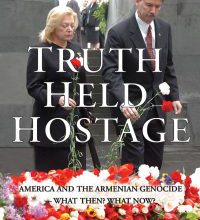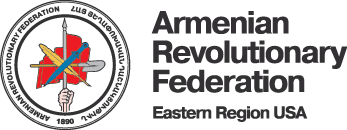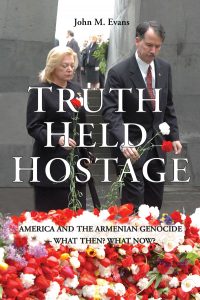Book Review: ‘Truth Held Hostage’

Truth Held Hostage: America and the Armenian Genocide – What Then? What Now?
By John M. Evans
Gomidas Institute, London (April 18, 2016); 170 pages
ISBN 978-1-909382-26-8, Hardcover; $32.00
By Garen Yegparian
Written in three parts, Truth Held Hostage by John Evans—the “martyred” U.S. Ambassador to Armenia who became a hero to Armenians all over the world—presents one man’s journey from ignorance, to awareness, and ultimately to action and thought provoking contemplation, all about the Armenian Genocide.
In the first part of the book, Evans describes his life’s journey into the U.S. Foreign Service and the Armenian universe along with the genocide that sits (unfortunately) at its core. His story is an example that ought to be emulated by any decent, earnest human being who encounters the Armenian Genocide for the first time. Evans describes his growing experience with Armenians, as he served in various diplomatic postings, including Iran. The reader easily and comfortably empathizes with the author as he grows into full awareness of the monstrous scale and ramifications of the genocide on human beings, Armenians, living around the world, but especially in the U.S. which Evans represents.
The second part starts with a resounding “yes” to the question of whether or not it was genocide. He then presents various legal, historical, and political considerations.
The third and final part is a “what next?” on the U.S., Turkey, Armenia, Diaspora, and international fronts. Among the interesting proposals Evans makes is that for the U.S., the way forward might be to recognize the genocide in an explicitly historical context, creating a distinction between that moral imperative and current geopolitical and policy considerations. He wraps up the book with ten suggestions to move forward, expressly stating that they are likely to be objectionable to both Armenians and Turks.
Herein is the strength of the book. It is not written as some obligatory path to be imposed on the opposing sides from on high. It sets out ideas based on Evans’s diplomatic experience and understanding of history and applicable laws. It creates space for discussion.
In this way, it is a perfect book for Armenians to not just read—but even more so—to give as a gift to non-Armenian friends. The latter will relate easily to the Ambassador’s fair-minded approach and the crisis of conscience which led him to finally utter “the G word,” resulting in his shortened tenure as U.S. Ambassador to Armenia, his early retirement, and the yanking of the Herter Award for Constructive Dissent on a technicality, which was just a cover for the State Department officials who were “incandescent” over Evans’s breach of the departmental taboo of even discussing the genocide.
In this way, Evans helped open the door (just a crack) so that the inertia of State Department bureaucracy was shifted enough for the topic to now be addressed a little more openly. He cites examples of this throughout the book.
I am very pleased that I bought and read the book after attending the discussion with Evans and Ara Sarafian, moderated by Salpi Ghazarian of the University of Southern California’s (USC) Armenian Studies Institute—the panel’s organizer. Sarafian is a founder of the Gomidas Institute, which is dedicated to publishing (and sometimes republishing) manuscripts and texts that are important sources of original data for Armenian studies. This book is the fifth by a diplomat that Gomidas has published. Three are by Americans who served in the Ottoman Empire— Morgenthau and his well-known book; Abram Elkus’s (Morgenthau’s successor) The Memoirs of Abram Elkus: Lawyer, Ambassador, Statesman; and Lewis Einstein’s (a little known State Department special agent) Inside Constantinople: A Diplomatist’s Diary During the Dardanelles Expedition, April-September, 1915, which was written as a cover for reporting what was being done to Armenians. The fourth is a Greek, third generation diplomat, Leonidas Chrysanthopoulos, whose Caucasus Chronicles: Nation-Building and Diplomacy in Armenia, 1993–1994 exposed the very real threat of a Turkish invasion that Armenia was under at that time. These are great resources and give a special, personal flavor to what might otherwise be dry reading.
That personal angle is very apparent in Evans’s book. For example, he mentions an Armenian who was a driver for the U.S. Embassy in Iran. I’ve already encountered someone in my personal circle who knew that driver. And, there are other figures from the Armenian community of the U.S. who figure into his narrative that we all know.
Buy, read, and gift this book, available in Armenian bookstores or directly from Gomidas Institute.
Source: Armenian Weekly Mid-West

